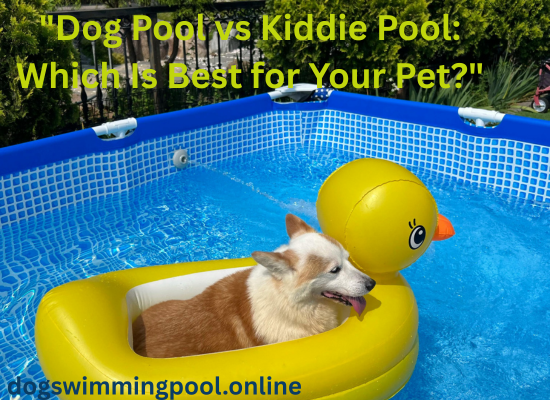Opt for a durable, chew-resistant dog pool (12–18” depth, non-slip floors) to withstand claws and prevent accidents. Kiddie pools (6–12”, bright colors) prioritize toddler safety with shallow water but lack pet-proof durability. Match the pool to its user—safety and purpose always come first!
Last summer, I thought buying a $20 kiddie pool for my Golden Retriever, Max, was a genius idea—until he punctured it within an hour. Turns out, not all pools are created equal. Whether you’re cooling off kids, pets, or both, picking the right pool matters more than you’d think. Let’s dive into the dog pool vs kiddie pool debate so you don’t repeat my mistakes.

Why Choosing the Right Pool Matters for Pets and Kids
A 2025 American Veterinary Medical Association study found that 1 in 5 pet injuries during summer stem from improper water setups. Meanwhile, the CDC reports that kiddie pools account for 15% of toddler drownings under 5 years old. The stakes are high, but the solution is simple: match the pool to its user.
Read more: Is swimming in salt water safe for dogs? Know all the information about it
- For dogs: Think heavy-duty materials like reinforced PVC (no flimsy plastic!).
- For kids: Prioritize shallow depths and slip-resistant floors.
- For dual use: Spoiler—it’s tricky. Most experts, like vet Dr. Sarah Lin, advise against mixing pools for safety reasons.
5 Costly Mistakes Pet Owners Make (And How to Avoid Them)

- Assuming “Bigger = Better”: My neighbor’s Great Dane flipped a 6-foot kiddie pool, soaking their patio. Lesson? Opt for wider, not deeper.
- Ignoring Drainage: Stagnant water breeds mosquitoes. A mom in Texas shared how her kiddie pool became a “mosquito condo” in just 3 days.
- Skipping Shade: Dogs can overheat faster than kids. Use a pop-up canopy or place the pool under a tree.
- Using Harsh Chemicals: Chlorine burns paws! Stick to pet-safe cleaners like vinegar solutions.
- Forgetting Exit Ramps: Senior dogs or small breeds? A ramp prevents panic (and vet bills).
Dog Pool vs Kiddie Pool: Key Differences You Can’t Ignore
| Feature | Dog Pool | Kiddie Pool |
| Material | Chew-resistant PVC | Thin plastic or inflatable |
| Depth | 12–18 inches | 6–12 inches |
| Safety | Non-slip floors | Bright colors for visibility |
| Price | 50–50–150 | 10–10–40 |
Pro Tip: If you’re on a budget, the Jasonwell Foldable Dog Pool ($45 on Amazon) survives even my pitbull’s zoomies.
Read more: Learn the best way to teach your pet dog to swim
Expert Tips for Maintaining Your Pool Year-Round
- Weekly Cleaning: Scrub with baking soda (safe for paws and skin).
- Winter Storage: Dry thoroughly to prevent mold—I learned this after finding my pool “science experiment” post-winter.
- Safety Checks: Patch holes ASAP with Flex Tape. Trust me, it’s a lifesaver.
Conclusion
So, which pool wins? If you’ve got furry kids, go dog-specific. For tiny humans, stick to shallow, colorful kiddie pools. Or better yet—get both and avoid the “who splashed who” drama. Try these tips and tag us in your poolside pics!
Read more: Indoor Dog Swimming Pool: A great safe fun way to keep your dog dynamic
FAQS
1. Can I use a kiddie pool for my dog?
Short-term? Maybe. But for daily use, invest in a dog-specific pool. Flimsy plastic won’t survive claws.
2. What’s the best material for a dog pool?
Reinforced PVC or heavy-duty polyethylene. Avoid inflatables—they’re squirrel-chase casualties waiting to happen.
3. How often should I change kiddie pool water?
Daily! Stagnant water attracts bacteria. Use a siphon pump ($12 at Walmart) to make draining easier.